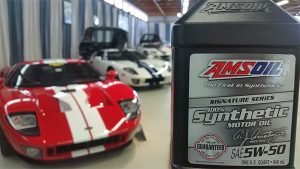To determine if straight-weight oil is best in your muscle car or hot rod, you first need to understand how it differs from multi-viscosity oil.
What those viscosity numbers mean
The oil’s viscosity is printed on the oil label in plain sight. But many people don’t know what the numbers (e.g. 5W-50) mean.
Get the full discussion on viscosity and what it means to engine protection here.
For our discussion, we can simply say this: most oil sold today is multi-viscosity. The first number refers to its viscosity, or resistance to flow, when cold (e.g. 5W).
Think of the “W” as standing for “winter.” The lower the number, the faster the oil will flow when cold, meaning a 5W-50 oil will flow faster at startup than a 20W-50 oil.
Better cold-flow = better start-up protection
This is a critical point.
Most engine wear occurs at startup when the engine is cold and has sat long enough to allow the oil to drip back into the sump, typically overnight. For best wear protection, you want an oil that’s going to flow quickly when you turn the key.
Oil that’s too thick may not flow through the tiny oil passages in, for example, the main bearings or upper end of the engine right away, allowing the engine to run for a few critical seconds with little oil pressure.
Normal operating temperature
The second number (e.g. 50) refers to the oil’s viscosity at 100ºC (212ºF), which approximates normal operating temperature in most engines.
Not to get too deep in the technical weeds, but the Society of Automotive Engineers (SAE) says a 50-weight oil must have a viscosity at 100°C (212ºF) of at least 16.3 centistokes (cSt) but less than 21.9 cSt.
The oil’s high-temperature/high-shear viscosity must also be at least 3.7 centipoise (cP) at 150°C (302°F).
The key takeaway here is that any 50-weight oil must meet these requirements, whether it’s a 5W-50, 15W-50 or straight-weight SAE 50 oil. Essentially, once the engine reaches operating temperature, their viscosities should be the same.
What’s the benefit of straight-weight oil?
About now, you might be wondering why someone would consider using a straight-weight oil since its viscosity is the same as a multi-weight oil at operating temperature, but it doesn’t provide the same cold-flow advantages.
The answer is shear stability.
Multi-viscosity oils use chemicals called viscosity index improvers to allow the oil to flow differently at different temperatures. For example, they allow a 20W-50 oil to behave like a 20-weight oil when cold and a 50-weight oil when warm.
As we’ve seen, this improves the oil’s ability to flow at startup, which maximizes wear protection.
Low-quality viscosity index improvers, however, can shear under stress. That means the pressure, stress and heat of the crankshaft, cam, pistons and other components churning at several thousand rpm can literally tear apart, or shear, these additives.
This reduces their effectiveness and causes the oil to lose viscosity, which reduces wear protection.
This is also a critical point since most muscle cars or hot rods are modified to make more power. And most drivers love to flirt with the redline at least occasionally, stressing the oil and increasing the likelihood of viscosity loss due to shear.
For that reason, it’s important to use an oil that retains its viscosity in severe conditions.
So, what’s right for you?
For the record, we recommend using a high-quality multi-viscosity oil instead of a straight-weight oil in your muscle car or hot rod.
You also want to consider an oil with added ZDDP if you’re running a flat-tappet cam.
Multi-viscosity oil provides the best of both worlds – reliable wear protection at startup and once the engine reaches operating temperature.
The key word, though, is “high-quality.”
As said, some oils can shear in the face of the severe conditions your engine can endure, leaving it vulnerable to wear.
At AMSOIL, we use premium base oils and additives in our formulations. They resist viscosity loss due to heat and mechanical shear to deliver reliable wear protection for your engine.
Originally published Jan. 12, 2016.








Comments
Share: